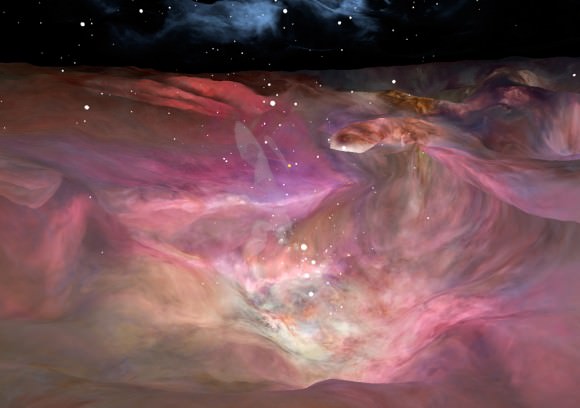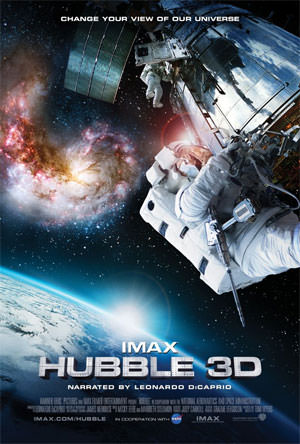[/caption]
I have seen the new Hubble 3-D IMAX movie twice now, and both times I was overcome with tears by the end of the film. It wasn’t that the story of Hubble itself was overwhelming; no, that story I already knew by heart. It wasn’t that the account of the servicing mission to save Hubble was especially dramatic; actually, I think watching the five EVAs live on NASA TV in May 2009 was more heart-pounding. And it wasn’t that the cinematography was overly stunning or that there were non-stop 3-D effects.
What this film does is portray the immensity and gloriousness of our universe, and that we are currently, serendipitously, living during an amazing era of discovery, one that humanity has never known before. Some of these discoveries we are only able to make because of this marvelous telescope and the people who laid their lives on the line to fix it and make it better. It also shows — almost subtly – that we are inexorably connected to the Universe around us, joined like the intertwining web of 3-D galaxies shown near the movie’s final scenes. We are witnessing – and are a part of – history.
The movie chronicles the 20-year life of Hubble, and focuses on the STS-125 servicing mission, the final mission to Hubble. There ARE wonderful 3-D views of Hubble itself, anchored to shuttle Atlantis’ payload bay, where the telescope appears to come out into the audience and into your lap. This includes stunning views of planet Earth spinning overhead. “This is a gift we astronauts have been given,” astronaut Mike Massimino says of the vistas that can only be seen from space.
And viewers get to experience not one, but two shuttle launches captured in the so-close-up-you-can-feel-it shots which can only be experienced in IMAX. But much of the footage from on-orbit detailing the EVAs and action inside the shuttle were shot with the regular, albeit high-tech cameras that normally NASA flies on missions, including the small “lipstick” cameras on the helmets of the spacewalkers, and some was able to be rendered in grainy, but effective 3-D. The only genuine IMAX 3-D camera on board the mission was bolted to the shuttle’s cargo bay and it carried only 5,400 feet of film – which translates into just 8 minutes of IMAX 3-D footage. Here’s an article about a 3 D Solar System
Endearing are the behind-the-scenes looks at the STS-125 mission. Astronauts joking with each other on orbit – Commander Scott Altman sticking gum under the shuttle’s “dashboard,” Massimino describing how suiting up for an EVA is like putting on a snowsuit as a child. “You need your Mom,” he says.
In both showings I attended, the scene that got the most audible reaction from the audience was Drew Feustal making a chicken salad tortilla wrap. But, hey, we all have to eat, and for those who have never seen food preparation or astronauts eating in space before, it holds a certain level of fundamental fascination.
Additionally we get to hear what is going through the minds of the astronauts on launch day. Mike Good recalls how his grandfather opened up the Universe by showing him views through a telescope. Megan McArthur glows with excitement. John Grunsfeld meticulously goes through in his mind all the tasks that lie before him and the crew.
The film quickly moves through the EVAs, highlighting anxious moments of the mission — stuck bolts, the handrail that Massimino had to rip off of Hubble, the tension of undertaking the meticulous repairs on a one-of-a-kind iconic telescope, all while wearing a bulky spacesuit. But within a 43 minute film, these situations are dealt with quickly, — and honestly, — the movie doesn’t give real justice to how tense some of these situations really were.

But most mesmerizing in the film are 3-D visualizations of actual Hubble data. For this film, regular 2-D Hubble images were converted into 3-D environments, giving the audience the impression they are traveling through space and time.
Viewers get to experience an exhilarating ride through the Orion Nebula, swooping through a giant canyon of gas and dust, and witness star-forming regions that include dusty tadpole-shaped objects that are fledgling solar systems, likely a vision of how our own solar system once looked.
Later we travel to the distant Virgo Cluster and emerge on the other side of a black hole, and then travel back in time to witness early misshapen galaxies. Returning to more recent views that include new images from the Wide Field Camera 3 that was installed on STS-125, we see an ocean of stars in multiple wavelengths. Upon pulling away from the stars, we see 3-D galaxies interwoven like a web.
It’s these mind-numbing visions that produce a child-like sense of awe and wonder – and in my case, tears. The film is a testament to how Hubble has allowed us to see the wonders of our Universe.
I asked for reactions from the members of the audience following the premier showing of Hubble 3-D at the Kennedy Space Center IMAX, and while many commented on the amazing graphics, they also observed how small they felt in comparison to the rest of the Universe, but yet, incredibly an integral part of all that is.
The graphics were created by image processing specialists at Hubble’s Space Telescope Science Institute,– familiar names to those of us that follow Hubble : Frank Summers, Zolt Levay, Lisa Frattare, and Greg Bacon. They worked with the National Center for Supercomputing Applications at the University of Illinois at Urbana-Champaign (more about them in a subsequent, upcoming article on Universe Today), and the Spitzer Science Center at the California Institute of Technology.
Hubble 3-D was directed by Toni Myers, who has been at the helm of all the space-themed IMAX movies, and narrated by Leonardo DiCaprio.
Go see the movie if you have the chance, and bring anyone who may not normally follow space exploration or astronomy. Their view of the Universe will never be the same.
For more info see the official Hubble 3-D IMAX website. Official trailer below.


I saw it last week at the Franklin Institute in Philadelphia (part of a special screening for NSTA meeting attendees) and they were only showing a standard version of it…no 3D! I was kind of bummed about that and wondering why. They had a sign up advertising Avatar in 3D at the theater.
I know there are a couple of different IMAX 3D technologies out there. I have seen IMAX 3D movies that use both active shutter glasses and standard linearly polarized 3D glasses. My first thought is that Hubble 3D uses one of the two technologies and the Franklin used the other one. Which technology does Hubble 3D use? Or is it available in both formats?
One of my personal favorite scenes in the movie was when they showed some old footage of Hubble construction in the clean rooms on the ground. That always drives home the point that people built this thing…people in funny suits at that! Humanizes it so much for me.
I’d go out of my way to see that! Hmmm…
I would love to see that movie!! But there is no IMAX cinema around where I live. Too bad!
Thats awesome and thanks for the review. Unfortunately there are no IMAX’s in illinois that are playing hubble till april. So i’ll have to wait.
Damn this all! I’m *HANGING* to see this. Doesn’t come out in the Sydney IMAX until frickin August though… Grrrr.
I saw this film the other night at The Henry Ford (Museum) in Detroit, Michigan. The IMAX theater there is one of the best in the nation and it didn’t disappoint. The film was sensational. “Child-like awe” was exactly how I put it to my wife when I returned home. As Nancy said, the story itself was not new to me but the experience of hanging over the blue marble with tether cables hanging (seemingly) over your shoulder as you observe EVAs as if you’re part of them is absolutely breathtaking. The trip to the Orion Nebula to see the “tadpoles” gives a great sense of scale and produced more than a few “WOW!”s from me and most of the audience around me. I’ll definitely be back to see it again and only have one (however unrealistic) complaint: 43 minutes ends up being an absolute tease by the time it’s done!
I agree with “jkudz”. I’ve been to IMAX theatres all over the United States and it’s true that the Henry Ford Museum in Detroit (Dearborn) MI is one of the best in the nation for it’s upgraded projection system, seating layout, room ambience and sound system. Astronaut Drew Feustal appearing in the movie is from my home town of Lake Orion, Michigan.
I saw ‘Hubble’ this past Saturday. Unfortunately there are no IMAX theaters in Ontario (Canada) that are playing the 3D version (/sigh…) It would have been excellent in 3D I would imagine.
Overall though, the movie was a bit disappointing, since it was only 45 minutes, they really didn’t need to include the old news footage, etc. Also since this film was targeted at the “unwashed masses” to enjoy, I would have thought they should have included a 3-5 minute explanation (with animations) about how Hubble works (some basics of telescopes) and you know, some general stuff. The movie seemed to ‘assume’ the audience would know all of this, but to truly appreciate it’s abilities, perhaps they should have spent a little less time showing the astronauts and a bit more time on the instrument itself.
That said, I still loved the film, but considering the minimal amount of running-time, they could have made better use (IMO). As I was leaving the theater, I overheard the usual comments, “omg, those space suits looked so cool…” and, “I didn’t know they could eat burritos in space…” both of which are expected comments, but come on! 😛